Synthesis and Antibacterial Activity of Rhodanine-Based Azo Dyes and Their Use as Spectrophotometric Chemosensor for Fe3+ Ions
Abstract
1. Introduction
2. Material and Methods
2.1. Chemistry
2.2. Synthesis of Rhodanine Azos 4a–c
2.2.1. General Procedure
2.2.2. (E)-3-Amino-5-(Naphthalen-2-Yldiazenyl)-2-Thioxothiazolidin-4-One (4a)
2.2.3. (E)-2-(5-(Naphthalen-2-Yldiazenyl)-4-Oxo-2-Thioxothiazolidin-3-Yl)Acetic Acid (4b)
2.2.4. 5-(Naphthalen-2-Yldiazenyl)-2-Thioxothiazolidin-4-One (4c)
2.3. Selectivity Studies for Metal Ions Using UV–Vis Spectroscopy
2.4. UV/Vis and Fluorescence Titration
2.5. Binding Stoichiometry Determination
2.6. Association Constant Determination
2.7. Detection Limit (LOD) Determination
2.8. Antibacterial Activity
2.8.1. Test Microorganisms
2.8.2. Minimum Inhibitory Concentration (MIC)
3. Results and Discussion
3.1. Synthesis
3.2. Spectroscopic Analysis
3.2.1. Response Time of Azos 4a–c for Metal Ions
3.2.2. Colorimetric Sensing and UV/Vis Studies
3.2.3. Binding Stoichiometry
3.2.4. Association Constant
3.2.5. Detection Limit
3.3. Biological Studies
Antimicrobial Activity
4. Conclusions
Supplementary Materials
Author Contributions
Funding
Acknowledgments
Conflicts of Interest
References
- Chen, H.; Cho, C.; Wan, F.; Wu, T. A colorimetric sensor for Fe2+ ion. Inorg. Chem. Commun. 2014, 41, 88–91. [Google Scholar] [CrossRef]
- El-Kady, A.A.; Abdel-Wahhab, M. Occurrence of trace metals in foodstuffs and their health impact. Trends Food Sci. Technol. 2018, 75, 36–45. [Google Scholar] [CrossRef]
- Khalid, S.; Shahid, M.; Natasha, B.I.; Sarwar, T.; Shah, A.H.; Niazi, N.K. A review of environmental contamination and health risk assessment of wastewater use for crop irrigation with a focus on low and high-income countries. Int. J. Environ. Res. Public Health. 2018, 15, 895. [Google Scholar] [CrossRef]
- Rull-Barrull, J.; d’Halluin, M.; Le Grognec, E.; Felpin, F.X. Chemically-modified cellulose paper as smart sensor device for colorimetric and optical detection of hydrogen sulfate in water. Chem. Commun. 2016, 52, 2525–2528. [Google Scholar] [CrossRef] [PubMed]
- Khedr, A.M.; Saad, F.A. Synthesis, structural characterization, and antimicrobial efficiency of sulfadiazine azo-azomethine dyes and their bi-homonuclear uranyl complexes for chemotherapeutic use. Turk. J. Chem. 2015, 39, 267–280. [Google Scholar] [CrossRef]
- Refat, M.S.; El-Sayed, M.Y.; Adam, A.M.A. Cu (II), Co (II) and Ni (II) complexes of new Schiff base ligand: Synthesis, thermal and spectroscopic characterizations. J. Mol. Struct. 2013, 1038, 62–72. [Google Scholar] [CrossRef]
- Kadhum, A.A.H.; Al-Amiery, A.A.; Musa, A.Y.; Mohamad, A.B. The antioxidant activity of new coumarin derivatives. Int. J. Mol. Sci. 2011, 12, 5747–5761. [Google Scholar] [CrossRef]
- Bayindir, S. A simple rhodanine-based fluorescent sensor for mercury and copper: The recognition of Hg2+ in aqueous solution, and Hg2+/Cu2+ in organic solvent. J. Photoch. Photobio. A 2019, 372, 235–244. [Google Scholar] [CrossRef]
- Lohani, C.R.; Lee, K.H. The effect of absorbance of Fe3+ on the detection of Fe3+ by fluorescent chemical sensors. Sens. Actuators B Chem. 2010, 143, 649–654. [Google Scholar] [CrossRef]
- Wang, C.; Zhang, D.; Huang, X.; Ding, P.; Wang, Z.; Zhao, Y.; Ye, Y. A fluorescence ratiometric chemosensor for Fe3⁺ based on TBET and its application in living cells. Talanta 2014, 128, 69–74. [Google Scholar] [CrossRef]
- Ghaedi, M.; Mortazavi, K.; Montazerozohori, M.; Shokrollahi, A.; Soylak, M. Flame atomic absorption spectrometric (FAAS) determination of copper, iron and zinc in food samples after solid-phase extraction on Schiff base-modified duolite XAD 761. Mater. Sci. Eng. C Mater. Biol. Appl. 2013, 33, 2338–2344. [Google Scholar] [CrossRef] [PubMed]
- Mustafa, Y.F. Synthesis of new coumarin derivatives with suspected anticoagulant activity. Iraqi J. Pharm. Sci. 2012, 12, 20–32. [Google Scholar] [CrossRef]
- Liu, X.; Li, N.; Xu, M.-M.; Wang, J.; Jiang, C.; Song, G.; Wang, Y. Specific colorimetric detection of Fe3+ ions in aqueous solution by squaraine-based chemosensor. RSC Adv. 2018, 8, 34860–34866. [Google Scholar] [CrossRef]
- Bobrowski, A.; Nowak, K.; Zarebski, J. Application of a bismuth film electrode to the voltammetric determination of trace iron using a Fe(III)-TEA-BrO3- catalytic system. Anal. Bioanal. Chem. 2005, 382, 1691–1697. [Google Scholar] [CrossRef] [PubMed]
- Sil, A.; Ijeri, VS.; Srivastava, AK. Coated-wire iron(III) ion-selective electrode based on iron complex of 1,4,8,11-tetraazacyclotetradecane. Sens. Actuators B Chem. 2005, 106, 648–653. [Google Scholar] [CrossRef]
- Lee, M.H.; Giap, T.V.; Kim, S.H.; Lee, Y.H.; Kang, C.; Kim, J.S. A novel strategy to selectively detect Fe(III) in aqueous media driven by hydrolysis of a rhodamine 6G Schiff base. Chem. Commun. 2010, 46, 1407–1409. [Google Scholar] [CrossRef]
- Marcus, Y. On the Use of the Molar Ratio Method for Determining Association Stoichiometry. Isr. J. Chem. 1967, 5, 143–149. [Google Scholar] [CrossRef]
- Benesi, H.A.; Hildebrand, J. A spectrophotometric investigation of the interaction of iodine with aromatic hydrocarbons. J. Am. Chem. Soc. 1949, 71, 2703–2707. [Google Scholar] [CrossRef]
- AlNeyadi, S.S.; Salem, A.A.; Ghattas, M.A.; Atatreh, N.; Abdou, I.M. Antibacterial activity and mechanism of action of the benzazole acrylonitrile-based compounds: In vitro, spectroscopic, and docking studies. Eur. Eur. J. Med. Chem. 2017, 136, 270–282. [Google Scholar] [CrossRef]
- Sarker, S.D.; Nahar, L.; Kumarasamy, Y. Microtitre plate-based antibacterial assay incorporating resazurin as an indicator of cell growth, and its application in the in vitro antibacterial screening of phytochemicals. Methods 2007, 42, 321–324. [Google Scholar] [CrossRef]
- Barreiro, J.; Milano, M.; Sandoval, A. Kinetics of colour change of double concentrated tomato paste during thermal treatment. J. Food Eng. 1997, 33, 359–372. [Google Scholar] [CrossRef]
- Noh, H.L.; Park, Y.K.; Oh, B.M.; Zheng, J.; Kim, S.-H.; Lee, W.; Jong, H.K. Colorimetric chemosensor for detection of a volatile organic compound, ethylamine, under versatile conditions: Solution, thin-film, and dyed fabric. Sens. Actuators B Chem. 2019, 301, 127079. [Google Scholar] [CrossRef]
- Natansohn, A.; Rochon, P. Photoinduced motions in azo-containing polymers. Chem. Rev. 2002, 102, 39–76. [Google Scholar] [CrossRef] [PubMed]
- Pal, S.; Chatterjee, N.; Bharadwaj, P.K. Selectively sensing first-row transition metal ions through fluorescence enhancement. RSC Adv. 2014, 4, 26585–26620. [Google Scholar] [CrossRef]
- Varnes, A.W.; Dodson, R.B.; Wehry, E. Interactions of transition-metal ions with photoexcited states of flavines. Fluorescence quenching studies. J. Am. Chem. Soc. 1972, 94, 946–950. [Google Scholar] [CrossRef]
- Li, J.; Wang, Q.; Guo, Z.; Ma, H.; Zhang, Y.; Wang, B.; Bin, D.; Wei, Q. Highly selective fluorescent chemosensor for detection of Fe3+ based on Fe3O4@ZnO. Sci. Rep. 2016, 6, 23558–23566. [Google Scholar] [CrossRef]
- Weerasinghe, A.J.; Abebe, F.A.; Sinn, E. Rhodamine based turn-ON dual sensor for Fe3+ and Cu2+. Tetrahedron Lett. 2011, 52, 5648–5651. [Google Scholar] [CrossRef]
- Yuan, X.; Luo, Z.; Yu, Y.; Yao, Q.; Xie, J. Luminescent noble metal nanoclusters as an emerging optical probe for sensor development. Chem. Asian J. 2013, 8, 858–871. [Google Scholar] [CrossRef]
- Shiraishi, Y.; Sumiya, S.; Kohno, Y.; Hirai, T. A Rhodamine−cyclen conjugate as a highly sensitive and selective fluorescent chemosensor for Hg(II). J. Org. Chem. 2008, 73, 8571–8574. [Google Scholar] [CrossRef]
- Kaur, K.; Chaudhary, S.; Singh, S.; Mehta, S.K. Highly selective probe based on imine linkage for Zn2+ and HSO3− in mixed aqueous media. J. Lumin. 2015, 160, 282–288. [Google Scholar] [CrossRef]
- Özdemir, Ö. Synthesis of novel azo linkage-based Schiff bases including anthranilic acid and hexanoic acid moieties: Investigation of azo-hydrazone and phenol-keto tautomerism, solvatochromism, and ionochromism. Turk. J. Chem. 2019, 43, 266–285. [Google Scholar] [CrossRef]
- Fu, Y.; Pang, X.X.; Wang, Z.Q.; Chai, Q.; Ye, F. A highly sensitive and selective fluorescent probe for determination of Cu (II) and application in live cell imaging. Spectrochim Acta A Mol. Biomol. Spectrosc. 2019, 208, 198–205. [Google Scholar] [CrossRef] [PubMed]
- Chen, H.; Bao, X.; Shu, H.; Zhou, B.; Ye, R.; Zhu, J. Synthesis and evaluation of a novel rhodamine B-based ‘off-on’ fluorescent chemosensor for the selective determination of Fe3+ ions. Sen. Actuators B Chem. 2017, 242, 921–931. [Google Scholar] [CrossRef]
- Kozak, L.; Niedzielski, P.; Wachowiak, W. The tandem analytical method of flow injection diode array spectrophotometry and flame atomic absorption spectrometry (FI-DAD(vis)-FAAS) in iron speciation studies using 1,10-phenanthroline complexes. Microchem. J. 2013, 110, 54–60. [Google Scholar] [CrossRef]
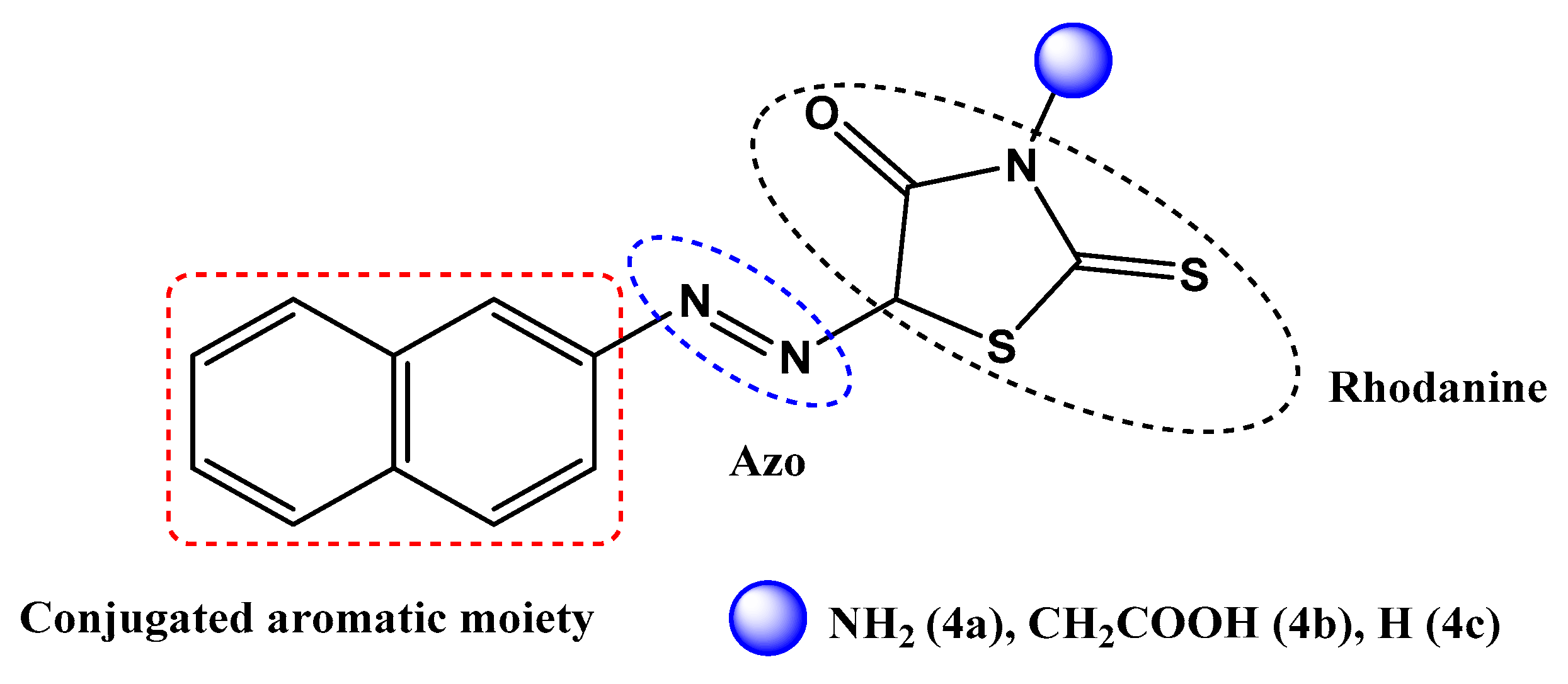



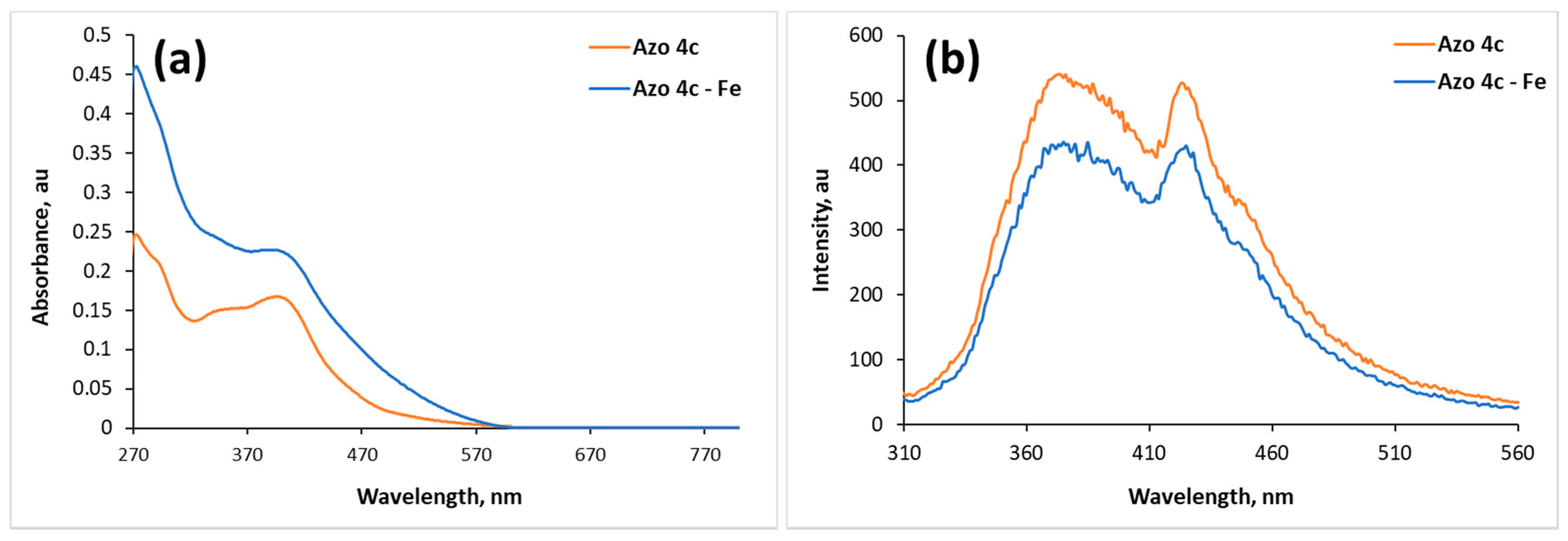
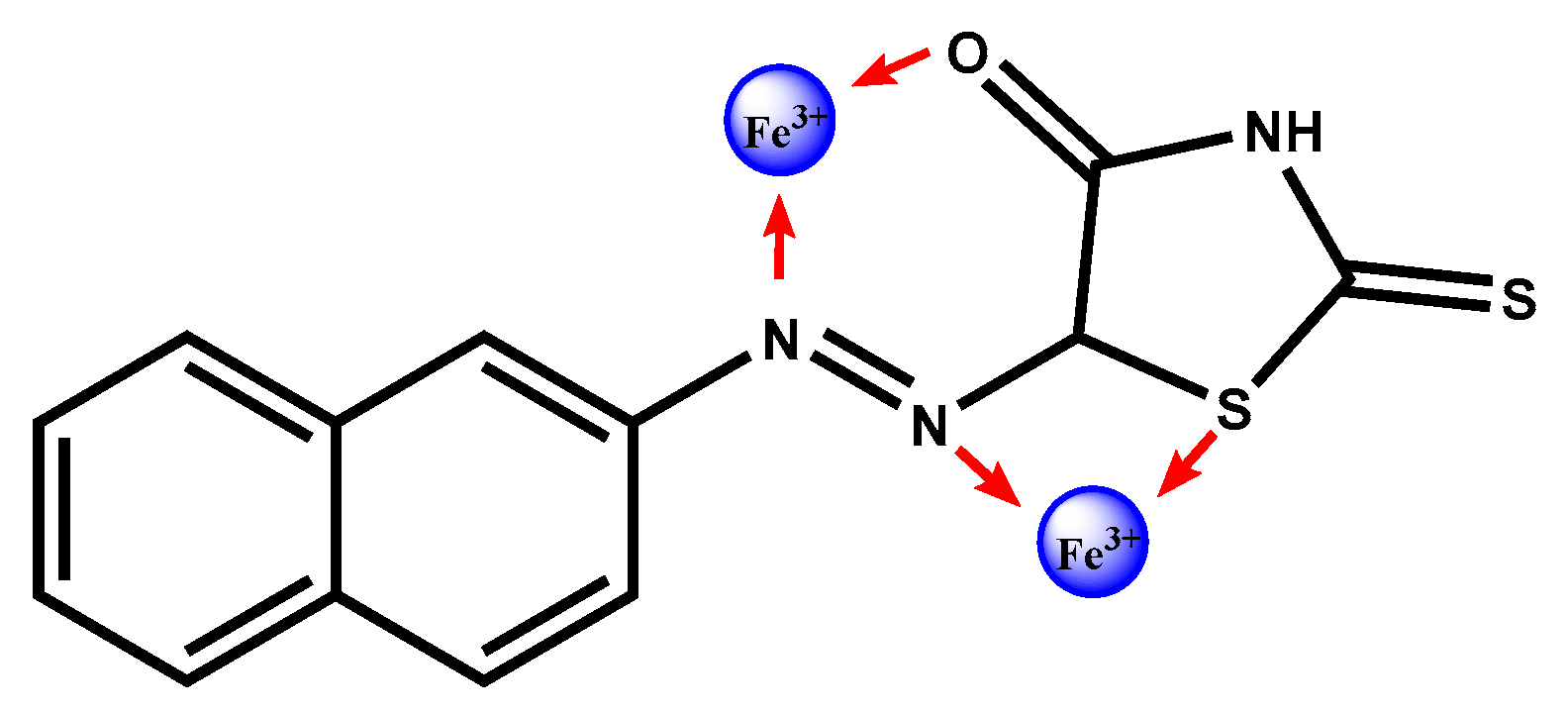
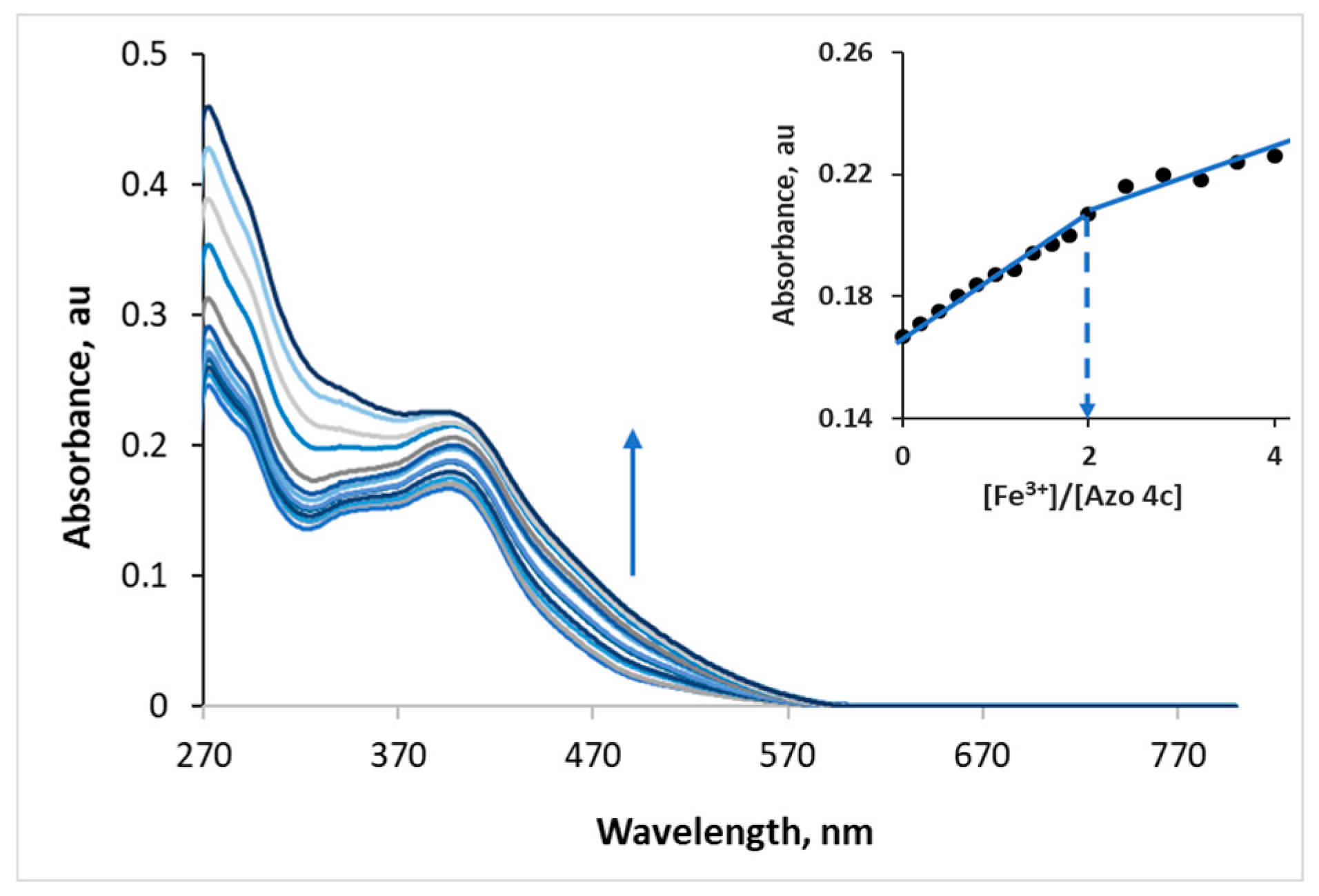

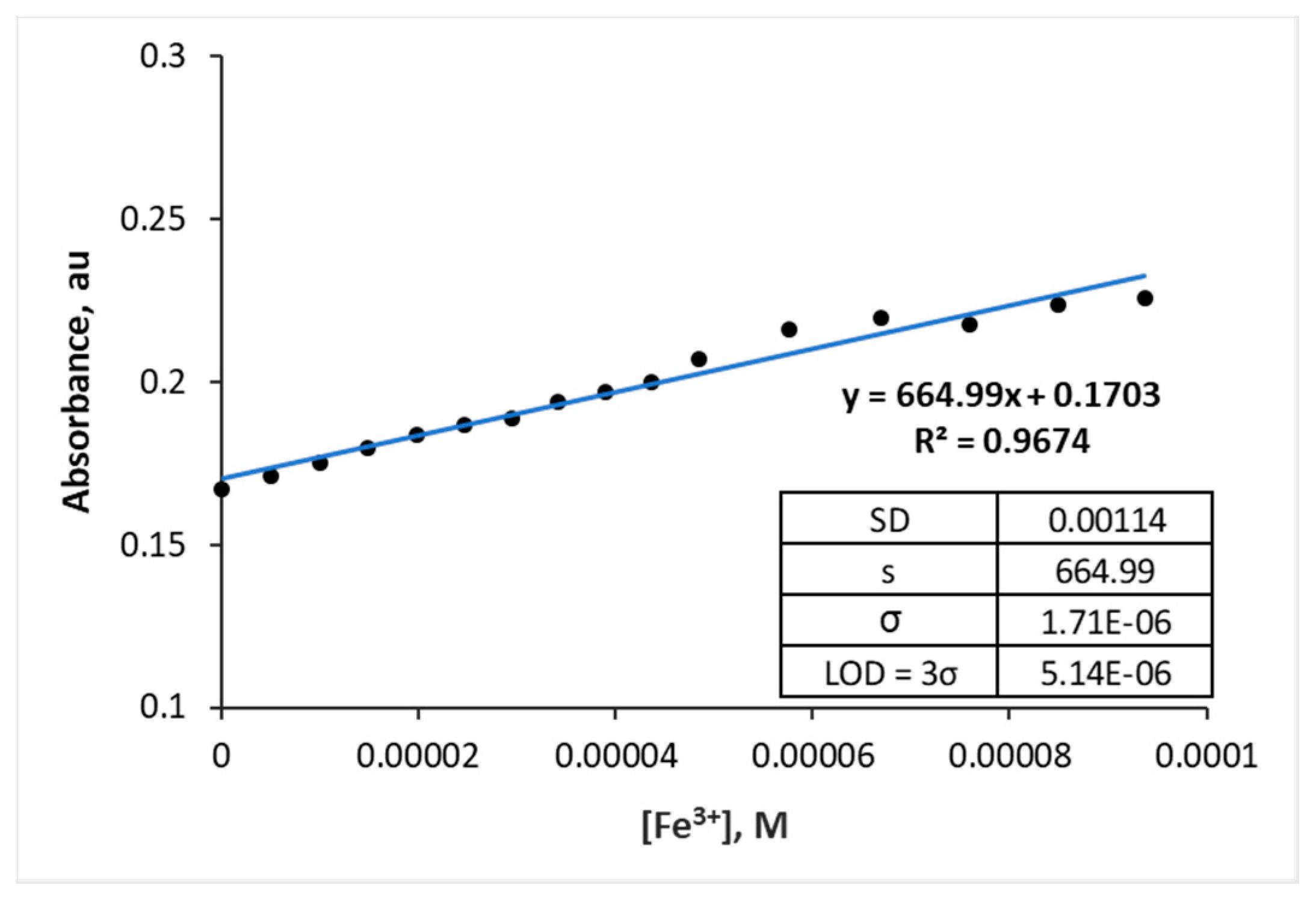
| Compounds | Zone of Inhibition (cm) * | MIC (μg/mL) | ||||
|---|---|---|---|---|---|---|
| E. coli | P. aeruginosa | S. aureus | E. coli | P. aeruginosa | S. aureus | |
| 4a | 0.7 | 0.9 | 0.8 | 2.5 | 2.5 | 2.5 |
| 4b | 0.9 | 1.0 | 0.7 | 1.25 | 2.5 | 1.25 |
| 4c | 0.6 | NA | 1.0 | 0.625 | NA | 1.25 |
| Amoxicillin | 0.8 | 2.2 | NA | 0.1 | 0.0125 | NA |
© 2020 by the authors. Licensee MDPI, Basel, Switzerland. This article is an open access article distributed under the terms and conditions of the Creative Commons Attribution (CC BY) license (http://creativecommons.org/licenses/by/4.0/).
Share and Cite
Akram, D.; Elhaty, I.A.; AlNeyadi, S.S. Synthesis and Antibacterial Activity of Rhodanine-Based Azo Dyes and Their Use as Spectrophotometric Chemosensor for Fe3+ Ions. Chemosensors 2020, 8, 16. https://doi.org/10.3390/chemosensors8010016
Akram D, Elhaty IA, AlNeyadi SS. Synthesis and Antibacterial Activity of Rhodanine-Based Azo Dyes and Their Use as Spectrophotometric Chemosensor for Fe3+ Ions. Chemosensors. 2020; 8(1):16. https://doi.org/10.3390/chemosensors8010016
Chicago/Turabian StyleAkram, Dana, Ismail A. Elhaty, and Shaikha S. AlNeyadi. 2020. "Synthesis and Antibacterial Activity of Rhodanine-Based Azo Dyes and Their Use as Spectrophotometric Chemosensor for Fe3+ Ions" Chemosensors 8, no. 1: 16. https://doi.org/10.3390/chemosensors8010016
APA StyleAkram, D., Elhaty, I. A., & AlNeyadi, S. S. (2020). Synthesis and Antibacterial Activity of Rhodanine-Based Azo Dyes and Their Use as Spectrophotometric Chemosensor for Fe3+ Ions. Chemosensors, 8(1), 16. https://doi.org/10.3390/chemosensors8010016




